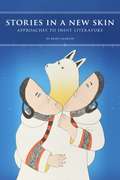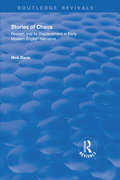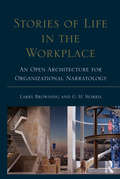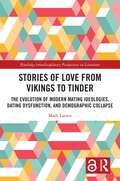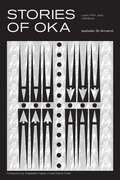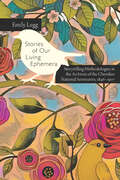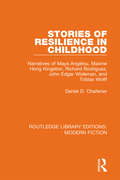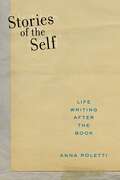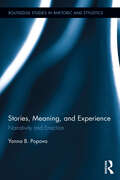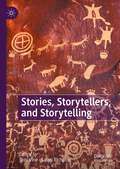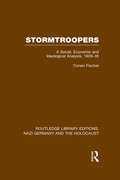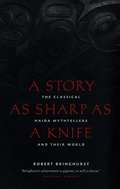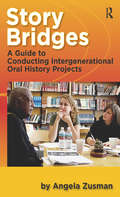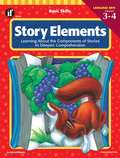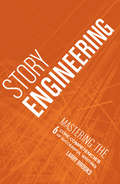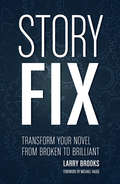- Table View
- List View
Stories from One Thousand and One Nights: For Intermediate and Advanced Students of Arabic
by Ghada BualuanSpecially designed for students of Arabic, this textbook presents a selection of authentic Arabian Night stories in simplified language providing learners of Modern Standard Arabic access to this classic of Arabic literature. Each story is fully supported by a range of comprehension, vocabulary-building, grammar reinforcement activities and exercises as well as an audio version of the story, which can be accessed at www.routledge.com/9781138948228. Ideal for class-use or self-study, students will enhance their reading, listening, and writing skills while developing the ability to analyze literary texts, reason critically, and broaden their understanding and appreciation of different layers of Arab culture.
Stories from a Moron: Real Stories Rejected by Real Magazines
by Ed BrothA nutty and hilarious book of magazine submissions and letters to and from the editors by the comedian, former Seinfeld writer, and Bee Movie cowriter.Foreword by Jerry SeinfeldEd writes short stories. He’s prolific. And desperate to get published. But he sends his stories to the wrong magazines. As for the magazines? Well, they don’t mind telling him so:“As a word of advice, it always helps for writers to be familiar with the publications they submit material to.” —Fencers Quarterly Magazine“Dear Ed: Thank you for your recent submission to Steamboat Magazine; it was wonderful to hear how much our magazine has touched you . . .”“Dear Mr. Broth: Thank you for the opportunity to review your article, ‘My Car Ride with Daddy,’ for possible publication in Mushing . . .”With this book, Ed Broth finally sees his work published. His “Stories of Hope & Inspiration” and his “Stories of Meaning & Sacrament” plus his passionate pitches to place his writing in our nation’s premier publications—from Pest Control Magazine to Arthritis Today—are all to be found in the book you hold in your hands.Some might have advised Ed not to send his story “I Love Dogs” to I Love Cats Magazine or to stop submitting revised stories to editors who have already turned them down. But, well, that’s just not the way Ed’s mind works. Studded like a rich cranberry strudel with nuggets of genius—from cartoons and advertisements to Ed’s newspaper articles from across the country—Stories from a Moron is an addictive journey into the mind of a great talent.
Stories in a New Skin: Approaches to Inuit Literature
by Keavy MartinIn an age where southern power-holders look north and see only vacant polar landscapes, isolated communities, and exploitable resources, it is important to note that the Inuit homeland encompasses extensive philosophical, political, and literary traditions. Stories in a New Skin is a seminal text that explores these Arctic literary traditions and, in the process, reveals a pathway into Inuit literary criticism. Author Keavy Martin considers writing, storytelling, and performance from a range of genres and historical periods – the classic stories and songs of Inuit oral traditions, life writing, oral histories, and contemporary fiction, poetry and film – and discusses the ways in which these texts constitute an autonomous literary tradition. She draws attention to the interconnection between language, form and context and illustrates the capacity of Inuit writers, singers and storytellers to instruct diverse audiences in the appreciation of Inuit texts. Although Eurowestern academic contexts and literary terminology are a relatively foreign presence in Inuit territory, Martin builds on the inherent adaptability and resilience of Inuit genres in order to foster greater southern awareness of a tradition whose audience has remained primarily northern.
Stories of Becoming: Demystifying the Professoriate for Graduate Students in Composition and Rhetoric
by Juliette C. Kitchens Claire Lutkewitte Molly J. ScanlonBased on findings from a multiyear, nationwide study of new faculty in the field of rhetoric and composition, Stories of Becoming provides graduate students—and those who train them—with specific strategies for preparing for a career in the professoriate. Through the use of stories, the authors invite readers to experience their collaborative research processes for conducting a nationwide survey, qualitative interviews, and textual analysis of professional documents. Using data from the study, the authors offer six specific strategies—including how to manage time, how to create a work/life balance, and how to collaborate with others—that readers can use to prepare for the composition and rhetoric job market and to begin their careers as full-time faculty members. Readers will learn about the possible responsibilities they may take on as new faculty, particularly those that go beyond teaching, research, service, and administration to include navigating the politics of higher education and negotiating professional identity construction. And they will also engage in activities and answer questions designed to deepen their understanding of the field and help them identify their own values and desired career trajectory. Stories of Becoming demystifies the professoriate, compares what current new faculty have to say of their job expectations with the realities that students might face when on the job, and brings to light the invisible, behind-the-scenes work done by new faculty. It will be invaluable to graduate students, those who teach graduate students, new faculty, and hiring administrators in composition and rhetoric.
Stories of Chaos: Reason and its Displacement in Early Modern English Narrative (Routledge Revivals)
by Nick DavisFirst published in 1999, this volume re-examines narrative design in Sir Gawain and the Green Knight, The Faerie Queene, King Lear and Paradise Lost. Written in a period newly set on finding practical application for available systems of reasoning, these texts confront in their different ways reason’s absolute limitation in the face of a Real which it cannot adequately represent to itself or recruit to its own purposes. An influential model for the staging of such a confrontation was the mythic, cosmological narrative of Plato’s Timaeus. In their rewriting of Plato’s narrative the English texts deploy but also destabilize the ancient conceptual polarization of the ‘rational’ and the ‘irrational’ or ‘chaotic’, rethought in the terms offered by their period’s innovatory practices of reasoning. The study establishes the critical importance of telling a story of chaos by comparing the narrative method of its chosen texts with that adopted by Freud and Lacan as a means of reflection on the psychoanalytic encounter with an ultimately chaotic Real. This book has unusual interdisciplinary scope, and offers historically grounded, theoretically informed new readings of four major early modern English literary texts.
Stories of Human Rights Module 1 Workbook
by El EducationEL Education is redefining student achievement in diverse communities across the country, ensuring that all students master rigorous content, develop positive character, and produce high-quality work.
Stories of Life in the Workplace: An Open Architecture for Organizational Narratology (Routledge Communication Series)
by George H. Morris Larry BrowningAddressing both renowned theories and standard applications, Stories of Life in the Workplace explains how stories affect human practices and organizational life. Authors Larry Browning and George H. Morris explore how we experience, interpret, and personalize narrative stories in our everyday lives, and how these communicative acts impact our social aims and interactions. In pushing the boundaries of how we perceive narrative and organization, the authors include stories that are broadly applicable across all concepts and experiences. With a perception of narrative and its organizational application, chapters focus on areas such as pedagogy, therapy, project management, strategic planning, public communication, and organizational culture. Readers will learn to: differentiate and gain an in-depth understanding of perspectives from varying narrators; recognize how stories are constructed and used in organizations, and modify the stories they tell; view stories as a means to promote an open exchange of creativity. By integrating a range of theories and practices, Browning and Morris write for an audience of narrative novices and scholars alike. With a distinctive approach and original insight, Stories of Life in the Workplace shows how individuality, developing culture, and the psychology of the self are constructed with language—and how the acceptance of one’s self is accomplished by reaffirming and rearranging one’s story.
Stories of Love from Vikings to Tinder: The Evolution of Modern Mating Ideologies, Dating Dysfunction, and Demographic Collapse (Routledge Interdisciplinary Perspectives on Literature)
by Mads LarsenIncreasing levels of singledom, dating dysfunction, and sexual inactivity contribute to plummeting fertility rates. This book investigates the perhaps most foundational factor behind this uncoupling: our present era’s ideology of love. Throughout human history, communities have shared fictional stories infused with various mating moralities that compel people to pair-bond and reproduce. After taking readers on a 6-million-year journey through hominin mating regimes—with various extents of promiscuity, polygyny, and monogamy—Stories of Love from Vikings to Tinder investigates the past millennium's radical evolution of Western mating beliefs. Nordic literary works illuminate the pivotal transitions between the West’s First, Second, and Third Sexual Revolutions, which occurred around the years 1200, 1750, and 1968. The conclusion chapter points to the Fourth Sexual Revolution, symbolically placed in 2029. Artificial intelligence and other technologies seem likely to transform our mating practices more radically than any of the previous revolutions.
Stories of Oka: Land, Film, and Literature
by S. E. Stewart Isabelle St. Amand Katsitsén:hawe Linda David CreeIn the summer of 1990, the Oka Crisis—or the Kanehsatake Resistance—exposed a rupture in the relationships between settlers and Indigenous peoples in Canada. In the wake of the failure of the Meech Lake Accord, the conflict made visible a contemporary Indigenous presence that Canadian society had imagined was on the verge of disappearance. The 78-day standoff also reactivated a long history of Indigenous people’s resistance to colonial policies aimed at assimilation and land appropriation. The land dispute at the core of this conflict raises obvious political and judicial issues, but it is also part of a wider context that incites us to fully consider the ways in which histories are performed, called upon, staged, told, imagined, and interpreted. "Stories of Oka: Land, Film, and Literature" examines the standoff in relation to film and literary narratives, both Indigenous and non-Indigenous. This new English edition of St-Amand’s interdisciplinary, intercultural, and multi-perspective work offers a framework for thinking through the relationships that both unite and oppose settler societies and Indigenous peoples in Canada.
Stories of Our Living Ephemera: Storytelling Methodologies in the Archives of the Cherokee National Seminaries, 1846-1907
by Emily LeggStories of Our Living Ephemera recovers the history of the Cherokee National Seminaries from scattered archives and colonized research practices by critically weaving together pedagogy and archival artifacts with Cherokee traditional stories and Indigenous worldviews. This unique text adds these voices to writing studies history and presents these stories as models of active rhetorical practices of assimilation resistance in colonized spaces. Emily Legg turns to the Cherokee medicine wheel and cardinal directions as a Cherokee rhetorical discipline of knowledge making in the archives, an embodied and material practice that steers knowledge through the four cardinal directions around all relations. Going beyond historiography, Legg delineates educational practices that are intertwined with multiple strands of traditional Cherokee stories that privilege Indigenous and matriarchal theoretical lenses. Stories of Our Living Ephemera synthesizes the connections between contemporary and nineteenth-century academic experiences to articulate the ways that colonial institutions and research can be Indigenized by centering Native American sovereignty. By undoing the erasure of Cherokee literacy and educational practices, Stories of Our Living Ephemera celebrates the importance of storytelling, especially for those who are learning about Indigenous histories and rhetorics. This book is of cultural importance and value to academics interested in composition and pedagogy, the Cherokee Nation, and a general audience seeking to learn about Indigenous rhetorical devices and Cherokee history.
Stories of Resilience in Childhood: Narratives of Maya Angelou, Maxine Hong Kingston, Richard Rodriguez, John Edgar Wideman and Tobias Wolff (Routledge Library Editions: Modern Fiction)
by Daniel D. ChallenerWhat helps a child overcome extraordinary obstacles? Why do some children surmount many difficulties and go on to live fulfilling lives while other children who face similar difficulties end up living desperate, sad lives? What helps children beat the odds? What builds resilience in children? These are critically important questions, yet for too long social scientists, doctors, psychologists and teachers have studied children who failed and tried to figure out what caused the failure. Only relatively recently have they begun to focus on what creates success. Originally published in 1997, this book is an effort to understand better what contributes to a child’s "success" and "resilience". The source of information will be autobiographies of childhoods – autobiographical stories written by adults remembering their difficult childhoods. This is not a research study or case study, rather it is an attempt to read and listen to five stories about resilient children and see what they can tell us about supporting children and building resilience.
Stories of the Self: Life Writing after the Book (Postmillennial Pop #27)
by Anna PolettiThe importance of personal storytelling in contemporary culture and politicsIn an age where our experiences are processed and filtered through a wide variety of mediums, both digital and physical, how do we tell our own story? How do we “get a life,” make sense of who we are and the way we live, and communicate that to others? Stories of the Self takes the literary study of autobiography and opens it up to a broad and fascinating range of material practices beyond the book, investigating the manifold ways people are documenting themselves in contemporary culture. Anna Poletti explores Andy Warhol’s Time Capsules, a collection of six hundred cardboard boxes filled with text objects from the artist’s everyday life; the mid-aughts crowdsourced digital archive PostSecret; queer zine culture and its practices of remixing and collaging; and the bureaucratic processes surrounding surveillance dossiers. Stories of the Self argues that while there is a strong emphasis on the importance of personal storytelling in contemporary culture and politics, mediation is just as important in establishing the credibility and legibility of life writing. Poletti argues that the very media used for writing our lives intrinsically shapes how we are seen to matter.
Stories that Changed America: Muckrakers of the 20th Century
by Hugh Downs Carl JensenExuberantly written, highly informative, Jensen's Stories That Changed America examines the work of twenty-one investigative writers, and how their efforts forever changed our country. Here are the pioneering muckrakers, like Upton Sinclair, author of the fact-based novel The Jungle, that inspired Theodore Roosevelt to sign the Pure Food and Drug Act into law; "Queen of the Muckrakers" Ida Mae Tarbell, whose McClure magazine exposés led to the dissolution of Standard Oil's monopoly; and Lincoln Steffens, a reporter who unearthed corruption in both municipal and federal governments. You'll also meet Margaret Sanger, the former nurse who coined the term "birth control"; George Seldes, the most censored journalist in American history; Nobel Prize-winning novelist John Steinbeck; environmentalist Rachel Carson; National Organization of Women founder Betty Friedan; African American activist Malcolm X; consumer advocate Ralph Nader; and Bob Woodward and Carl Bernstein, the Pulitzer Prize-winning reporters whose Watergate break-in coverage brought down President Richard Nixon. The courageous writers Jensen includes in this deftly researched volume dedicated their lives to fight for social, civil, political and environmental rights with their mighty pens.
Stories, Meaning, and Experience: Narrativity and Enaction (Routledge Studies in Rhetoric and Stylistics)
by Yanna B. PopovaThis is a book about the human propensity to think about and experience the world through stories. ‘Why do we have stories?’, ‘How do stories create meaning for us?’, and ‘How is storytelling distinct from other forms of meaning-making?’ are some of the questions that this book seeks to answer. Although these and other related problems have preoccupied linguists, philosophers, sociologists, narratologists, and cognitive scientists for centuries, in Stories, Meaning, and Experience, Yanna Popova takes an original interdisciplinary approach, situating the study of stories within an enactive understanding of human cognition. Enactive approaches to consciousness and cognition foreground the role of interaction in explanations of social understanding, which includes the human practices of telling and reading stories. Such an understanding of narrative makes a decisive break with both text-centred approaches that have dominated structuralist and early cognitivist views of narrative meaning, as well as pragmatic ones that view narrative understanding as a form of linguistic implicature. The intersubjective experience that each narrative both affords and necessitates, the author argues, serves to highlight the active, yet cooperative and communal, nature of human sociality, expressed in the numerous forms of human interaction, of which storytelling is one.
Stories, Storytellers, and Storytelling
by Tom Vine Sarah RichardsThis book advances social scientific interest in a field long dominated by the humanities: stories, and storytelling. Stories are a whole lot more than entertainment; oral narratives, novels, films and immersive video games all form part of the sociocultural discourses which we are enmeshed in, and use to co-construct our beliefs about the world around us. Young children use them to learn about the world beyond their immediate sensory experience and, even in an era of interactive electronic media, the bedtime story remains a cherished part of most children’s daily routine. Storytelling is thus the first abstract formal learning method we encounter as human beings. It is also probably transcultural; perhaps even an immanent part of the human condition. Narratives are, at heart, sequences of events and presuppose and reinforce particular cause-and-effect relationships. Inevitably, they also construct unconscious biases, prejudices, and discriminatory attitudes. Storying (a term we use in this book to encompass stories, storytellers and storytelling) is complex, and this book seeks to make sense of it.
Storm of Steel
by Michael Hofmann Ernst JungerThe memoir widely viewed as the best account ever written of fighting in WW1<P> A memoir of astonishing power, savagery, and ashen lyricism, Storm of Steel illuminates not only the horrors but also the fascination of total war, seen through the eyes of an ordinary German soldier. Young, tough, patriotic, but also disturbingly self-aware, Jünger exulted in the Great War, which he saw not just as a great national conflict but—more importantly—as a unique personal struggle. Leading raiding parties, defending trenches against murderous British incursions, simply enduring as shells tore his comrades apart, Jünger kept testing himself, braced for the death that will mark his failure. Published shortly after the war’s end, Storm of Steel was a worldwide bestseller and can now be rediscovered through Michael Hofmann’s brilliant new translation.
Storming the Reality Studio: A Casebook of Cyberpunk & Postmodern Science Fiction
by Larry MccafferyThe term "cyberpunk" entered the literary landscape in 1984 to describe William Gibson's pathbreaking novel Neuromancer. Cyberpunks are now among the shock troops of postmodernism, Larry McCaffery argues in Storming the Reality Studio, marshalling the resources of a fragmentary culture to create a startling new form. Artificial intelligence, genetic engineering, multinational machinations, frenetic bursts of prose, collisions of style, celebrations of texture: although emerging largely from science fiction, these features of cyberpunk writing are, as this volume makes clear, integrally related to the aims and innovations of the literary avant-garde.By bringing together original fiction by well-known contemporary writers (William Burroughs, Thomas Pynchon, Don DeLillo, Kathy Acker, J. G. Ballard, Samuel R. Delany), critical commentary by some of the major theorists of postmodern art and culture (Jacques Derrida, Fredric Jameson, Timothy Leary, Jean-François Lyotard), and work by major practitioners of cyberpunk (William Gibson, Rudy Rucker, John Shirley, Pat Cadigan, Bruce Sterling), Storming the Reality Studio reveals a fascinating ongoing dialog in contemporary culture.What emerges most strikingly from the colloquy is a shared preoccupation with the force of technology in shaping modern life. It is precisely this concern, according to McCaffery, that has put science fiction, typically the province of technological art, at the forefront of creative explorations of our unique age. A rich opporunity for reading across genres, this anthology offers a new perspective on the evolution of postmodern culture and ultimately shows how deeply technological developments have influenced our vision and our art. Selected Fiction contributors: Kathy Acker, J. G. Ballard, William S. Burroughs, Pat Cadigan, Samuel R. Delany, Don DeLillo, William Gibson, Harold Jaffe, Richard Kadrey, Marc Laidlaw, Mark Leyner, Joseph McElroy, Misha, Ted Mooney, Thomas Pynchon, Rudy Rucker, Lucius Shepard, Lewis Shiner, John Shirley, Bruce Sterling, William VollmanSelected Non-Fiction contributors: Jean Baudrillard, Jacques Derrida, Joan Gordon, Veronica Hollinger, Fredric Jameson, Arthur Kroker and David Cook, Timothy Leary, Jean-François Lyotard, Larry McCaffery, Brian McHale, Dave Porush, Bruce Sterling, Darko Suvin, Takayuki Tatsumi
Stormtroopers: A Social, Economic and Ideological Analysis 1929-35 (Routledge Library Editions: Nazi Germany and the Holocaust)
by Conan FischerThis examination of Hitler’s stormtroopers provides vital insights into the collapse of the Weimar Republic and the establishment of the Nazi state. Drawing on a wide range of archival sources and extensive biographical material left by the stormtroopers themselves, the author challenges the belief that Hitler’s SA was predominantly lower-middle class. This revealing study of street politics during an era of economic and political dislocation and is an important contribution to the history of inter-war Germany which will appeal to the advanced undergraduate and postgraduate reader alike.
Story As Sharp As A Knife: The Classical Haida Mythtellers And Their World
by Robert BringhurstThe Haida world is a misty archipelago a hundred stormy miles off the coasts of British Columbia and Alaska. For a thousand years and more before the Europeans came, a great culture flourished in these islands. The masterworks of classical Haida sculpture, now enshrined in many of the world's great museums, range from exquisite tiny amulets to magnificent huge housepoles. Classical Haida literature is every bit as various and fine. It extends from tiny jewels crafted by master songmakers to elaborate mythic cycles lasting many hours. The linguist and ethnographer John Swanton took dictation from the last great Haida-speaking storytellers, poets and historians from the fall of 1900 through the summer of 1901. His Haida hosts and colleagues had been raised in a wholly oral world where the mythic and the personal interpenetrate completely. They joined forces with their visitor, consciously creating a great treasury of Haida oral literature in written form. Poet and linguist Robert Bringhurst has worked for many years with these century-old manuscripts, which have waited until now for the broad recognition they deserve. Bringhurst brings these works to life in the English language and sets them in a context just as rich as the stories themselves--one that reaches out to dozens of Native American oral literatures, and to mythtelling traditions around the globe. The world of classical Haida literature is a world as deep as the ocean, as close as the heart and as elusive as the Raven, whose unrepentant laugh persists within it all. This is a tradition brimming with profundity, hilariy and love. It belongs where Bringhurst sees it: among the great traditions of the world. Bringhurst, an acclaimed typographer and book designer, will be redesigning this edition in a beautiful new package.
Story Based Selling
by Jeff BloomfieldAs a founder of a successful organization that trains and develops sales professionals, Jeff Bloomfield has given a lot of thought to why customers say yes. In Story-Based Selling: Create, Connect, and Close, Mr. Bloomfield says it's really no mystery. People buy from people they trust. They trust people they like, and they like people they connect to. And he believes that storytelling is the best way for salespeople-and all of us-to immediately connect to a customer's feelings of trust and liking. He thinks teaching sales professionals to close a deal by presenting their product, probing its mutual benefits, and overcoming the customer's objections and skepticism, is a waste of time. Instead, he urges them to tell a great story. Mr. Bloomfield calls upon the latest research in neuroscience to explain the process of communication. The truth is that during the salesperson's engagement with clients, people quickly base their decisions on how they feel, not the way they think, so trying to persuade someone by first imparting lifeless facts and figures is self-defeating. In fact, this information goes right to an area of the listener's brain (the left brain) that drives doubt and skepticism. To make a deal we need to connect with the parts of the customer's brain that inspire emotions of trust and empathy. By telling a story, we can immediately connect to these good gut feelings and drive away the client's fear of being sold. Mr. Bloomfield tells his own engaging stories while teaching step-by-step techniques of intentional storytelling-to create a fast connection with the listener, no matter who is buying or what a person wants to sell.
Story Bridges: A Guide for Conducting Intergenerational Oral History Projects (Practicing Oral History #1)
by Angela ZusmanAngela Zusman offers an informative guidebook with step-by-step directions for planning and implementing intergenerational oral history projects, using youth to interview elders. An expert on these programs, Zusman uses her experiences and those of other oral historians to show how community projects are organized, youthful historians located and trained, interviews conducted, and the project archived for future community needs. Included are a variety of sample documents and case studies designed to ease the process for the uninitiated.
Story Development for Children's Books: Tips and Techniques to Get Your Story Back on Track (The Everything® Writing Series)
by Adams MediaHave you run into writer’s block? Not sure how to take the next step in your children’s book plot? Beat your block and keep your story moving with The Everything® Writing Series: Story Development for Children’s Books. You’ll be able to get your tale back on track with these helpful tips and ideas. With some quick reading, you’ll be back to writing in no time.
Story Elements: Learning About The Components of Stories to Deepen Comprehension
by Kathryn WheelerStory Elements--Grades 3-4 is designed to introduce young readers and writers to the tools that authors use as they create stories. The activities explore the concepts of character, setting, problem (conflict), and plot. The book is divided into sections for each concept, with mixed-skills pages at the end. In each section, activities progress from an introductory page to more challenging exercises. Pages from this book can be used individually to strengthen the recognition of a specific element, or to introduce it as a topic. Teachers might want to use certain pages on more difficult concepts-such as identifying a story's climax-to help review the material after it has been worked on in class.
Story Engineering
by Larry BrooksWhat makes a good story or a screenplay great? The vast majority of writers begin the storytelling process with only a partial understanding where to begin. Some labor their entire lives without ever learning that successful stories are as dependent upon good engineering as they are artistry. But the truth is, unless you are master of the form, function and criteria of successful storytelling, sitting down and pounding out a first draft without planning is an ineffective way to begin. Story Engineering starts with the criteria and the architecture of storytelling, the engineering and design of a story--and uses it as the basis for narrative. The greatest potential of any story is found in the way six specific aspects of storytelling combine and empower each other on the page. When rendered artfully, they become a sum in excess of their parts. You'll learn to wrap your head around the big pictures of storytelling at a professional level through a new approach that shows how to combine these six core competencies which include:Four elemental competencies of concept, character, theme, and story structure (plot) Two executional competencies of scene construction and writing voice The true magic of storytelling happens when these six core competencies work together in perfect harmony. And the best part? Anyone can do it!
Story Fix: Transform Your Novel from Broken to Brilliant
by Larry Brooks Michael HaugeReinvigorate Your Fiction!You've written the first draft of your novel or screenplay, and you've released it into the world: to your critique group, to your most trusted beta readers, or even to an agent or an editor. But something's wrong. You're not getting the glowing response you had expected, or you might have even received a rejection. Your story is getting a "Meh..." when you had hoped for an "Amazing!"But have no fear--the piece you've sweated and bled over isn't dead on arrival. It just needs fixing.Story Fix is the answer to your revision needs. With practical techniques from critically acclaimed author and story coach Larry Brooks, you will learn how to:Develop a story-fixing mind-setNavigate the two essential realms of revision: story and executionEvaluate your novel or screenplay against twelve crucial storytelling elements and essences.Strengthen your concept and premise.Punch up the dramatic tension, pacing, thematic weight, characterization, and more.Align your story with proven structural principles.Filled with candid advice on the realities of the publishing world and helpful case studies of real authors who fixed their own stories, Story Fix isn't just about revision--it's about resurrection. Infuse your fiction with a much-needed jolt of electricity, and bring it back to life."Larry Brooks is a superb storyteller and teacher. If anyone can fix your novel, it's him. Put this one on your desk and read it often." --Robert Dugoni, #1 Amazon and New York Times best-selling author of My Sister's Grave"Story Fix is the ultimate writer's companion for taking any manuscript to the next level. A staple for the beginner, a refresher for the pro." --Joe Moore, #1 Amazon and international best-selling co-author of The Blade and The Shield


